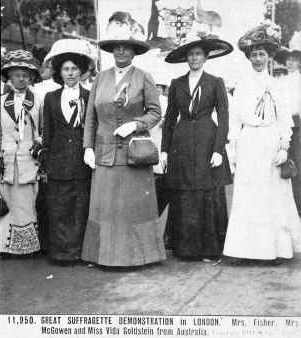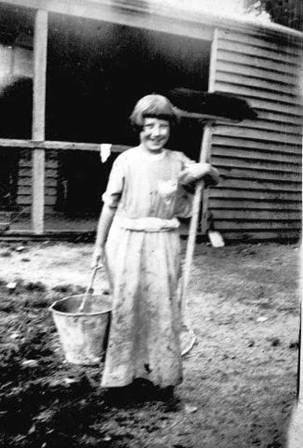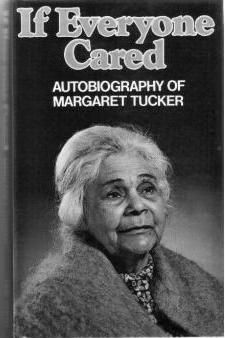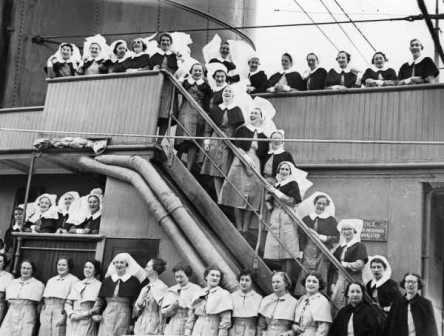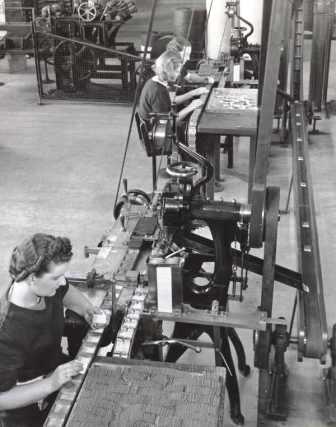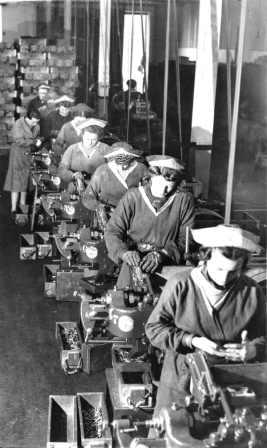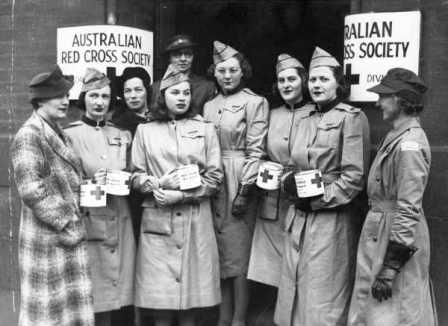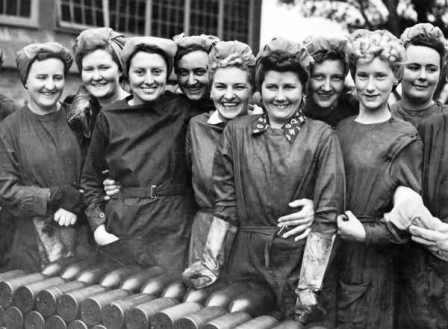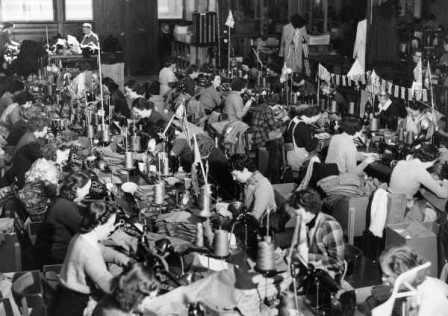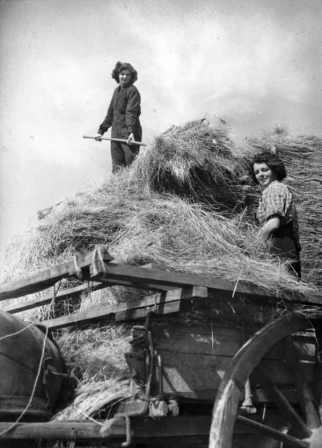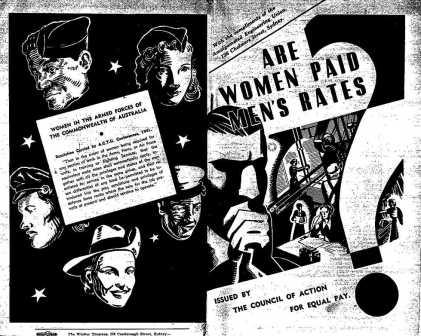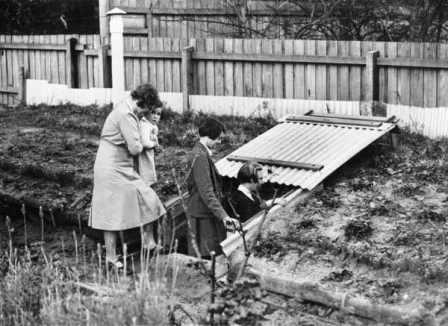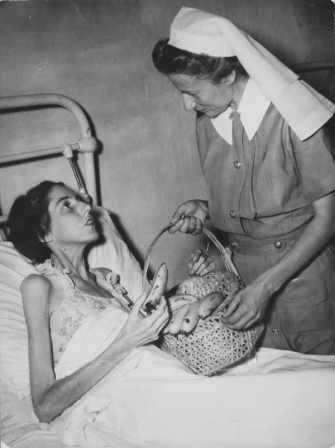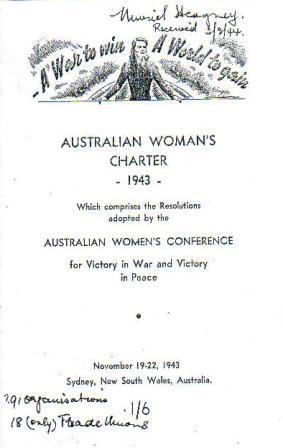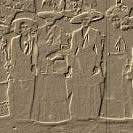 |
WOMEN WORKING TOGETHER |
THIS SITE CONTAINS
1 to 5 - Winning the vote
Chapter 1: The Vote or Bust 1788-1908
Chapter 2: Who Were the Suffragists?Chapter 3: 'United and Representative Agitation'
Chapter 4: Anti-Suffragists 1900-1910Chapter 5: Onwards to Success 1884-1908
6 to 10 - Social Justice and peace
Chapter 6: Moving into the Public World
Chapter 7: 1914-18 War - Pro Peace, Pro and Anti War
Chapter 8: Women's Work in WW1
Chapter 9: 1919-1935 - Surviving
Chapter 10: 1935-1945 Still Surviving
11 to 15 - Finding our voice as women
Chapter 11: 1945 and after - In Our Own Right
Chapter 12: 1970's Protesting - Working Together Again
Chapter 13: Finding Our Voice - Women's Liberation
Chapter 14: Working Collectively
Chapter 15: The 1970's & 80's Broader Women's Movement
16 to 20 - Our legacy our strength our struggle
Chapter 16: In Our Own Hands - Our Bodies
Chapter 17: Whose Right to Choose?- Our Selves
Chapter 18: Environment Matters
Chapter 19: 1990's When the Women's Movement is Quiet
Chapter 20: What a Legacy We Inherit!
Appendix 1: Papers and Interviews
Appendix 2: Songs from the Women's Movement
WOMEN FROM THE
WOMEN'S MOVEMENT
MENTIONED IN THIS WORK.
Abigail Adams
Ada Brougham
Adela Pankhurst
Adrian Howe
Agnes Murphy
Aileen Goldstein
Ailsa O'Connor
Alayne Park
Alex Butler
Alice B Toklas
Alice Henry
Alice Moon
Alice Suter
Alice Walker
Alice Weekes
Alina Holgate
Alisa Burns
Alison Alexander
Alison Dickie
Alison Richards
Alix McDonald
Alma Morton
Alma Thorpe
Andrea Coote
Annie McKenzie
Alva Geike
Amanda Bede
Amanda Biles
Amanda Graham
Amelia Ceranas
Amelia Lambrick
Amira Ingliss
Amy Castilla
Angelina Austin
Angelina Wonga
Ann Jackson
Anna Brennan
Anna Howie
Anna Morgan
Anna Pha
Anna Shaw
Anna Stewart
Anne Barker
Anne Carson
Anne Conlon
Anne Gowers
Anne Phelan
Anne Riseborough
Anne Stewart
Anne Summers
Annette Bear-Crawford
Annie Lister
Annie Lowe
Annie McKenzie
Anthea Hyslop
Antonie Stolle
Ariel Couchman
Audrey Oldfield
Barb Friday
Barbara Creed
Barbara Hall
Barbara Jones
Barbara Kerr
Barbara Marsh
Barbara Van Meurs
Barbara Wishart
Beatrice Faust
Bella Lavender
Belle McKenzie
Bertha Main
Beryl Carter
Bessie Harrison-Lee
Bessie Rainer Parkes
Bessie Rischbieth
Bette Olle
Betty Richmond
Bev Kingston
Bon Hull
Brettena Smyth
Brienne Callahan
Brigid McCaughey
Bronwyn Pike
Candy Broad
Carmel Shute
Carmen Callil
Carmen Lawrence
Carole Ford
Carole Wilson
Caroline Huidobro
Caroline Landale
Carolyn Allport
Carolyn Jay
Carolyn Worth
Carrie Chapman Catt
Carrie Reed
Caryl Friedman
Cath Mayes
Cath Stone
Catherine Anne Spence
Catherine Blackburn
Catherine McLennan
Cecilia John
Charlotte P Gilman (Stetson)
Cheris Kramarae
Cheryl Griffin
Chris Cathie
Chris Chapman
Chris Sitka
Chris Zsizsman
Christina Frankland
Christina Stead
Christine Haag
Churls Kramarae
Claire Berry
Clara Weekes
Clare Wright
Claudia Wright
Colleen Hartland
Constance Stone
Cynthis Carson
Dale Dowse
Dale Spender
Daphne Gollan
Deb Schnookal
Deborah Jordan
Deborah Wardley
Di Fruin
Di Otto
Di Surgey
Diane Crunden
Diane Kirby
Diane Sonnenberg
Dianne Edwards
Dianne Scott
Dianne Wells
Dimity Reed
Divna Devic
Dominica Whelan
Dora Coates
Doris Blackburn
Doris Challis
Doris McRae
Dorothy Turner
Dr Adrian Howe
Dr Aletta Jacobs
Dr Clara Stone
Dr Clare Isbister
Dr Constance Stone
Dr Helene Stocker
Dr Georgina Sweet
Dr Gwen Fong
Dr Janet Bacon
Dr Jocelynne Scutt
Dr Lyn McKenzie
Dr Marie Stopes
Dr Mary Glowrey
Dr Mary Stone
Dr Tamara McKean
Duggie Silins
Edie Turnevich
Edith Hedger
Edith Morgan
Edith Taylor
Edna Ryan
Eileen Capocchi
Eileen Kampukuta Brown
Eileen Unkari Crombie
Eleanor Dark
Eleanor Harding
Eleanor Hobbs
Eleanor M Moore
Elizabeth Cady Stanton
Elizabeth Coady
Elizabeth Hooke
Elizabeth Jackson
Elizabeth Ramsay-Laye
Elizabeth Reid
Elizabeth Rennick
Elizabeth Wallace
Elizabeth Wheelahan
Elizabeth Windshuttle
Ellen Julia Gould
Ellen Kleimaker
Ellen Ward
Elphinstone Dick
E McAllister
Emily Dobson
Emily Greene Balch
Emily Munyungka Austin
Emily Pankhurst
Emmaline Pankhurst
Emmy Evald
Ethel Barringer
Eugenie Davidson
Eva Eden
Eva Cox
Eva Figes
Eve Fesl
Eve Gray
Evelyn Gough
Evelyn Greig
Farley Kelly
Fiona Colin
Fiona Moorhead
Fleur Finney
Flo Kennedy
Flora Eldershaw
Florence Kelly
Frances Fraser
Frances Kissling
Fraulein Von Heymann
Freda Durham
Freda Gamble
Freda Steinberg
Frida Kahlo
Florence Miller
Gay Harris
Gayle Tierney
Gaylene Sneadon
Geraldine Briggs
Geraldine Robertson
Georgina McEnroe
Germaine Greer
Gertrude Bussey
Gertrude Stein
Gill Alecto
Gillian Waite
Gina Lewis
Gisela Kaplan
Glen Tomasetti
Greta Pearce
Gudren Drewsen
Gwendolen Swinburne
Harriet Taylor Mill
Hazel Donelly
Heather Jeffcoat
Heather Osland
Helen Anderson
Helen Caldicott
Helen Dow
Helen Durham
Helen Palmer
Helen Reddy
Helen Robertson
Helen Shardey
Helen Sexton
Hellen Cooke
Henrietta Dugdale
Henry Handel Richardson
Hetty Gilbert
Ilka Elkemann
Ina Higgins
Irina Dunn
Isabel McCorkindale
Isabella Goldstein
Isabella Martinis
Ivy Makinta Stewart
Jaala Pulford
Jacinta Allen
Jackie Fristacky
Jacqui Katona
Jan Armstrong Cohn
Jan Bassett
Jan Harper
Jan Mercer
Jan Testro
Jane Addams
Jane Alley
Jane Greig
Jane Mullett
Janet Bacon
Janet Bell
Janet Elefmiotis
Janet Lindsay Greig
Janet McCalman
Janet Michie
Janet Strong
Janey Stone
Janice Brownfoot
Janice Munt
Janine Bourke
Janne Reed
Jean Bedford
Jean Daley
Jean Henry
Jean McLean
Jean Melzer
Jean Sims
Jean Taylor
Jean Thompson
Jeanette Fenelon
Jeanette Powell
Jeanette Rankin
Jeni Thornley
Jennifer Clark
Jennifer Feeney
Jennifer Lee
Jennie Baines
Jenny Bacon
Jenny Barwell
Jenny Lee
Jenny Mikakos
Jenny Rimmer
Jenny Tatchell
Jesse Marlow
Jessie Ferguson
Jessie Henderson
Jessie Mcleod
Jessie Street
Jenny Pausaker
Jessie Street
Jessie Taylor
Jill Jolliffe
Jill Parkes
Jill Reichstein
Jill Roe
Jo Ellis
Jo MacLaine-Cross
Jo Phillips
Jo Wainer
Joan Coxsedge
Joan Curlewis
Joan E Basquil
Joan Goodwin
Joan Elkington
Joan King
Joan Kirner
Joan Rosanove
Joan Rowlands
Joanna Rea
Joanne Duncan
Jocelyne Clarke
Joe Dolce
Josephine Butler
Josie Lee
Joy Damousi
Joyce Barry
Joyce Johnson
Joyce Nicholson
Joyce Stevens
Jude Perera
Judi Willis
Judith Smart
Judy Cassar
Judy Morton
Judy Power
Judy Maddigan
Judy Small
Julia Church
Julia So So
Julianne Fogarty
Julie McCrossin
Julie Shiels
Juliette Mitchell
Kamla Bhasin
Karen Bird
Karen Gillespie
Karen Milgram
Karen Overington
Karen Silkwood
Karina Veal
Kate Darian-Smith
Kate Gilmore
Kate Jennings
Kate Miller
Kath Williams
Katherine Mansfield
Katherine Suzannah Prichard
Kathie Gleeson
Kathie Sarachild
Kathleen Fitzpatrick
Kathleen Maltzahn
Kathryn Sutherland
Kathy Gill
Kathy Wilson
Katrina Veal
Kay Daniels
Kaye Darveniza
Kay Hamilton
Kay Hargreaves
Kay Setches
Kaz Cooke
Keitha Carter
Kerry Blundell
Kerryn & Jenny
Kris Wilkinson
Lady Helen Munro-Ferguson
Lariane Fonseca
Laura Daniele
Laura Van Nooten
Laurie Bebbington
Lena McEwan
Lesbia Harford
Lesley Hewitt
Lesley Podesta
Lesley Stern
Lesley Vick
Leslie Cannold
Leslie Henderson
Lexie Methereall
Libby Brook
Libby Minifie
Lilian Alexander
Lilian Wald
Lily D'Ambrosia
Linda Aarchen
Linda Rubenstein
Linn Van Hek
Lisa Neville
Lisa Shuckroon
Liz Beattie
Liz Byrski
Liz Dowling
Liz Taylor
Lois Bryson
Lois Young
Lorri Manning
Louisa Lawson
Louisa Remedios
Louise Asher
Louise Walford
Lorna Scarles
Lucy Kowing Wilton
Lucy Paling
Lydia Becker
Lyla Barnard
Lyn Chambers
Lyn Hovey
Lyn McKenzie
Lynne Kosky
Mabel Drummond
Mandy Paul
Maree Gladwin
Margaret Bevege
Margaret Baskerville
Margaret Geddes
Margaret James
Margaret Mead
Margaret McKenzie
Margaret McLean
Margaret Roadknight
Margaret Thorp
Margaret Tims
Margaret Tucker
Margot Oliver
Maree Gould
Maria Mies
Marian Sawer
Marian Simms
Marian Vickers
Marie Kirk
Marie McInnes
Marie Rowan
Marion Harper
Marilyn Beaumont
Marilyn Hillgrave
Marilyn Lake
Marsha Thomson
Marylin Waring
Marilyn Wise
Marj Oke
Marjorie Barnard
Marjorie Barrett
Marjorie Waters
Mary Astell
Mary Bartlett
Mary Brodney
Mary Crooks
Mary Fullerton
Mary Gilbert
Mary Grant
Mary Killury
Mary Leigh
Mary Merkenich
Mary Murnane
Mary Owen
Mary Page Stone
Mary Rogers
Mary Salce
Mary Wolstonecraft
Mary Wooldridge
Matron Brown
Maxine Morand
May Brodney
May Langbridge
May Scheidt
May Smith
Megan McMurchy
Melanie Hall
Melinda Freyer
Melvina Ingram
Meredith Tax
Mesdames: Wallace; Baines;
Lavender; Webb; Singleton;
Morris; Gardiner; Reynolds,
Reid.
Mesdames Savage and Bella Lavender
Miles Franklin
Millicent Garrett Fawcett
Miss A Hume
Miss Anderson
Miss C H Thomson
Miss Cuthbertson
Miss D McRae
Miss E Goldstein
Miss E Hedger
Miss Effie Smart
Miss E Nesbit
Miss Geraldine Rede
Miss H Bridger
Miss H McGowan
Miss Harriet Newcomb
Miss Hilda Moody
Miss Jane Adams
Miss Janet Michie
Miss Jeanette Rankin
Miss Judd
Miss L Savage
Miss Lawler
Miss Lillian Locke
Miss Lillian Wald
Miss Mary Fullerton
Miss Miriam Geach
Miss Olive Gray
Miss R Smethurst
Miss Rapier
Miss Selina Cooper
Miss Simmons
Miss Wollen
Miss Stoddart
Miss V Bonner
Misses: Lewis; McMahon; Helsby;
Moody; Wise; Pascoe; Stewart;
Goodwin; Grant etc.
Misses: Mulcahy; Delaney; Townsend;
McGrath; Clements; Collins; Triffle; Cohen; McLean
Moira Rayner
Mollie Baine
Mollie Dyer
Molly Hadfield
Monika Wells
Morag Loh
Madame E Lorton Campbel
Mrs Anna B Howie
Mrs Bella Lavender Halloran
Mrs Beresford Jones
Mrs Bochinon
Mrs Brown
Mrs Catherine P Wallace
Mrs Chesterfield
Mrs Crawford
Mrs Crutchfield
Mrs D Irwin
Mrs D Monsbourgh
Mrs D Nankivell
Mrs Dwyer
Mrs E Hampton
Mrs E M Nimmo
Mrs E Pethridge
Mrs E Rothfield
Mrs Elliot
Mrs E W Nicholls
Mrs Emily Jackson
Mrs Evelyn Gough
Mrs F J Nicholls
Mrs F Williams
Mrs Florence Kelly
Mrs Fryer
Mrs Fisher
Mrs G Cameron
Mrs Goldstein (senior)
Mrs H A Dugdale
Mrs Harrard
Mrs Harrison Lee
Mrs Jamieson
Mrs Janet Strong
Mrs Jessie Vasey
Mrs Joan Rosanove
Mrs Josephine Butler
Mrs Kelly
Mrs Langdale
Mrs Laura Howie
Mrs Lister Watson
Mrs Lowe
Mrs Lucy Paling
Mrs M Hartley
Mrs M B Wollaston
Mrs M Mayall
Mrs Mabel Drummond
Mrs Malcolm
Mrs Martin
Mrs Mary Baird
Mrs Maudsley
Mrs M McGowan
Mrs Moody
Mrs Moore
Mrs Nance Wills
Mrs Naylor
Mrs O'Dowd
Mrs P Eden
Mrs Press
Mrs Pymm
Mrs Renwick
Mrs Robertson
Mrs Rosanov
'Mum' Shirl
Mrs Singleton
Mrs Smythe
Mrs Steele
Mrs Strong
Mrs Warren Kerr
Mrs Z Lees
Muriel Heagney
Myra Roper
Nan Chelsworth
Nancy Kessing
Nancye Smith
Narelle Dwyer
Nawal El Saadawi
Nettie Palmer
Nicole Steinke
Nina Bondarenke
Norma Grieve
Olive Gray
Olive Schreiner
Onnie Wilson
Pam Brewster
Pam Roberts
Pamela Branas
Pamela Curr
Pat Freeman
Pat Gowland
Pat Martin
Patricia Filar
Patsy Adam-Smith
Paula Trechler
Pauline Kennedy
Pauline Pickford
Peggy Cullinan
Penny Cooke
Penny Farrer
Penny Ryan
Peta Tait
Petra Munro
Philippa Hawker
Ponch Hawkes
Prof. Jo Wainer
Prof. Margaret Thornton
Rachel Avery
Rachel Hesley
Rae Walker
Raelene Frances
Ramona Koval
Rebecca West
Renate Howe
Renate Klein
Renee Miller
Renee Romeril
Rhoda Bell
Rigmor Berg
Rivka Pile
Roberta Meilleur
Robin Morgan
Robin Royce
Robyn Archer
Robyn Martin
Robyn Rowland
Romawati Senaga
Ros Bowden
Rose Scott
Rosemarie Gillespie
Rosemary Brown
Rosie Ferber
Ruby Rich
Ruby Tuesday
Ruth Bermann
Ruth Crow
Ruth Ford
Ruth Schnookal
Sabine Fernheicher
Sadie Kirsner
Sally Mendes
Sally Wilkins
Sandra Bloodworth
Sandra Onus
Senator Olive Zakharov
Sharon Jones
Sheila Bayard
Sheila Ricci
Sheila Wynn
Shirley Andrews
Shirley Swain
Sister Gladys Sumner
Sister Blake
Sister Brown
Sister Hannah
Sophie Slater
Stephanie Moore
Sue Jackson
Sue Mountford
Sue Pennicuik
Sue Reid
Sue Russell
Susan Anthony
Susan Hawthorne
Susie Grezik
Susy Potter
Suzane Fabian
Sylvia Azzopardi
Sylvia Plath
Sylvie Leber
Sylvie Shaw
Tammy Lobato
Tanya McIntyre
Teresa Magna
Terri Jackson
Terry Carney
Tess Lee-Ack
Tess Maloney
Thelma Fry
Thelma Lees
Thelma Prior
Thelma Solomon
Therese Radic
Theresa Lynch
Tjunmutja Myra Watson
Tjuta Ivy Makinti Stewart
Tracey Gurd
Tricia Caswell
Tricia Szirom
Trish Crick
Trudy Wise
Una Stannard
Val Ogden
Val Osborne
Vandana Shiva
Verity Bergmann
Vweronica Shwarz
Vida Goldstein
Virginia Geddes
Virginia Woolf
Vivien Brophy
Vivienne Binns
Wendy Lovell
Wendy Lowenstein
Wendy Poussard
Win Graham
Winsome McCaughey
Yolana Sutherland
Yosano Akiko
Yvonne Margarula
Yvonne Smith
Zara Wildenaur
Zelda D'Aprano
Zoe PhillipsThis work is copyright.
Please acknowledge the source/sources of anything you use.Every effort has been made to trace the people used on this site. Please contact us if you have any questions or concerns about our use of material.
Website advice:
Jean McConnachie
Editorial advice:
Barbara Hall, also Apsara Sabaratnam, Jean McConnachie, Irene Stavrakakis, Margaret Allison, Ramona Audrey, Waratah Rose Gillespie
Legal advice:
Matthew Nicholls
The forthcoming book is funded by Women's Web members and associates: Barbara Hall, Geraldine Robertson, Mary Crooks, Zelda D'Aprano
If you would like to contribute, please contact us.
CHAPTER 10 - 1935-45 The Charter - Still Surviving
The peace treaty created "discords and animosities which can only lead to future wars"
Zurich Women's Conference
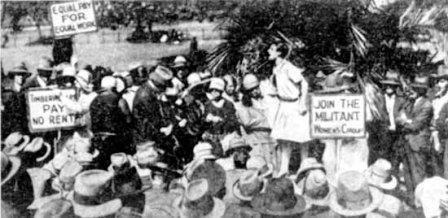
1931 Equal Pay Rally Militant Women's Group - Miss Jean Thompson
They worked to prevent another war; they worked for better pay and conditions; the right to work; better living standards; they worked for Aboriginal rights;. With the women's movement quiet, many joined the Communist Party.
1...WOMEN'S INTERNATIONAL LEAGUE FOR PEACE AND FREEDOM (WILPF)
Eleanor Moore: 'The League of Nations Commission for the Welfare of Native Peoples had, to our worldwide discredit summed up Australia's treatment of Aborigines as "uniformly bad." Just about this time there seems to have been a special wave of harshness. At Darwin eight Aborigines were sentenced to death for the murder of two white men. Here again we protested. Our letter, published in the Argus, (Melbourne), put the case thus - "Would any court in Australia sentence eight white men to death for the murder of two natives? We know it would not ... So wars of extermination start."
Another suggestion was the planting of an international peace garden ... through the efforts of combined women's societies, the Pioneer Women's Garden was established on the hillside above the Yarra, a little west of the Botanic Gardens. Meanwhile there was considerable passing to and fro of persons prominent in the peace movement. Miss Sophie Slater ... A prominent Australian who returned to Melbourne after many years residence in the USA was Miss Alice Henry, whose wisdom and experience were always at the service of the peace movement ... The attack upon China by Japan caused much speculation as to whether the League of Nations should or would or could intervene. No action in restraint of Japan was taken. On the contrary, the great European Powers and the United States of America continued the sale of armaments to both sides, but in greater quantity to the Japanese, who were better able of the two to pay for them. The protests of many pacifists against this course of action passed unheeded.'
The attack on Abyssinia by Italy caused a deeper stir in public feeling than any political event since the beginning of the First World War ... Public disgust worked itself out in a series of indignation meetings. Such was one convened in Melbourne by a combination of women's societies, under the spur of a piteous appeal sent out by the Empress of Abyssinia. It was chaired by Mrs I H Moss and was intended to be the first of an enlarging series. But the war continued its course unchecked and made its way through massacre, in the normal military manner, towards conquest and annexation.' The Quest for Peace As I Have Known It In Australia
CHARTER OF HUMAN RIGHTS: 'A Call to All Australians - A Just Social Order - War on Unemployment - 'World wide Unemployment and Economic Insecurity and their resultant misery, in the midst of illimitable plenty, is the greatest challenge to offered humanity since the Great War, and Australian women who are the Nation's home builders, are resolved that, as far as Australia is concerned, they will no longer tolerate these cruel injustices in silence. They therefore appeal to Church, Business, Industrial Social and Political Organisations to sink all differences of opinion and unite for the purpose of carrying on a campaign of Education, preliminary to a Plan of Action, regarding the various proposals brought forward for bring about a better social system.' The Royal Historical Society in Melbourne holds a paper
2...1935 THEY WORKED FOR EQUAL PAY
Muriel Heagney said the reason she wrote Are Women Taking Men's Jobs, 1935, was to respond to: ' ... the current propaganda against women in industry, implying that women and girls were taking men's jobs and thereby becoming a contributory factor in general unemployment'.
Muriel Heagney: 'Maternity can only be fairly and effectively protected when a woman is left in full possession of her rights as an adult human being. Neither marriage, nor pregnancy, nor childbirth, nor nursing a child are reasons for depriving her of the human right to decide for herself.
Muriel Heagney: 'The sphere of women's work appears to be more circumscribed in Australia than in other countries, of the 909 trades and callings listed by the Commonwealth Statistician, women are recorded in only 87, whereas, in America, for several decades the census returns show women working in all but thirty or forty of the total trades reported. The justification for women's claims in the 1926 Clothing Trades Union case for an equal minimum or basic wage was primarily a demand for the right to complete economic independence for women workers and a frank declaration that a woman's contribution to production is equally valuable to that of a man.
She believed: '... The right to work is no prerogative of men ... Women's right to work rests not on her dependents, nor on the fact that she does or does not compete with men, but in the absolute right of a free human being, a taxpayer and a voter, to economic independence.' And was concerned that: '... In Australia, India and France, the ratio is 52% of the male rate, whereas in Great Britain it is 58%, United States 59% and Sweden 61%.' Muriel Heagney papers, State Library of Victoria
Jean Daley: 'In certain bad old days there was a custom of describing those women who thought and were public spirited as 'shrieking sisters' ... In February 1937 Nettie Palmer became the Melbourne editress of Woman Today, a small monthly magazine which aimed to offer a forum, an organising force to support the efforts of all women and of all organisations of women against war, for the right to work, for equal rights, for a better living standard and for peace.' Jean Daley Trade Union Woman SLV
Deborah Jordan: '(Nettie's) relationship with Lesbia Harford, Katherine Suzannah Prichard, Henry Handel Richardson, Miles Franklin, Marjorie Barnard, Flora Eldershaw and Christina Stead ... reveal her concern to improve the social, aesthetic and intellectual values of Australian society ... Her feminism was implicit in her life as a radical, in her high ideals, and in her attempt to embody them in the every day environment as an Australian woman.' thesis, Nettie Palmer: Aust Women and Writing 1885-1925 STL
The anti-feminist Australian Women's National League (AWNL) had argued for a wage for wives paid by husbands - "Wages for Women". The feminist Muriel Heagney recommends a payment by the State for mothers and children and that men share the housework -
Muriel Heagney: ' ... With over two decades experience in trade union agitation for improved living conditions for all workers to supplement personal experience, I am convinced that family life will never reach the ideal standard we desire until the economic value of the services of the woman in the home is recognised by a special allowance from the State ... At the first ACTU Conference held in Melbourne in 1921 I moved a resolution which still summarizes my view on the matter. The resolution was seconded by Mr J M Badderly, representative of the Miners' Federation, and was carried unanimously. It reads:- "That this Congress endorses the principle of the endowment of motherhood and childhood, thereby recognising the service rendered to the community by the mother in the care and nurture of the child, such payment to be a charge on the whole community, and be recognised as an individual right, and not associated in any way with the economic circumstances of the husband or father."
The system of child endowment instituted by the Commonwealth Government is along these lines and if extended until the inherent right of every child to access the best social opportunities available combined with a special allowance for the mother were recognised, the community would benefit immeasurably. You will observe that I have made no provision for the childless married woman. I do so advisedly. My plan for special allowances for women is based not on their sex but on the service rendered to the community in the upbringing of a family. ... The household chores could be shared by both husband and wife ...' Muriel Heagney Notes, State Library of Victoria
1925 PA008744 Museum Victoria5...1937 THEY FORMED THE COUNCIL OF ACTION FOR EQUAL PAY
It activated the union movement and was instrumental in organising the first International Conference on Equal Pay (1938).
Elizabeth Windschuttle (ed): 'Delegates to the Council of Action for Equal Pay (CAEP) sponsored Conference on Women and Children in Industry in Wartime, in August 1940, expressed strong disapproval of the emphasis that the Commonwealth Government was placing "on the need for voluntary unpaid work of women and girls in war services of an industrial character, whilst, at the same time, all our legislative and judicial authorities are completely ignoring the new special problems inherent in the socially necessary paid work of women and youths." p 380 Women, Class and History Feminist Perspectives on Australia 1788-1978 Fontana/Collins 1980
Ryan and Conlon: 'The objective of the Council was "advocacy of the rate for the job irrespective of the sex of the workers, the elimination of sex differentials in legal industrial standards, the achievement of equal status and equality of opportunity for workers of either sex". p 122 Edna Ryan and Anne Conlon The Gentle Invaders Australian Women at Work 1788-1974 Nelson 1975
Many women also participated in the COUNCIL AGAINST WAR and FASCISM or the COMMUNIST PARTY -
Edith Morgan: 'Bill eventually was in the air force, training as a navigator, and so I went to Sydney to live. That is where all my kids were born, in Sydney. That was when I joined the Communist Party, so that was another life for me. I was involved with Ernie Thornton, of the Ironworkers Union, and his wife. They just lived up the road. I got entangled with them and had wide association with communists in New South Wales. There wasn't anti-Communist feeling then. Probably the only one who was really anti-Communist then was Menzies. He was a very strong influence, and of course it was touch-and-go whether we supported Hitler in those early years. Of course you would have been too scared to support Hitler after the war had been going for some time, particularly when the Soviet Union came in.' Edith Morgan Women's Web Women's Stories Women's Actions pub. UAW http://www.womensweb.com.au
Wendy Lowenstein (obituary for Shirley Aldythea Andrews): 'In 1934 as Hitler got into his stride, this conservative young woman was impelled to join the Council Against War and Fascism. She enjoyed telling of political awakening.
"Two of us were door-knocking in Kew, and at the very first door the woman ordered us off the property with 'You're a lot of communists!' I was absolutely amazed ... I was really so very middle-class!"Later she did join the Communist Party and passionately supported world peace, industrial health and women's issues. She left the party in the mid-1950s, in protest at Stalin's violent move into Eastern Europe. An early feminist, Shirley graduated in science when women students were barely tolerated. ... However, it was in her work as an activist for Aboriginal rights, 1951 to 1968, that she made her greatest contribution to Australian society, though her modesty led to her work being greatly under-recognised.' Victorian Folk Music Club http://users.bigpond.net.au/vfmc/ShirleyObit.htm
6...1937 THE PAN PACIFIC WOMEN'S ASSOCIATION (PPWA) Conference
'Maintaining Peace through International Understanding' -
Eleanor Moore: 'A third Pan-Pacific Women's Conference met at Honolulu in 1933, and a fourth at Vancouver in 1937, when the Conference topic was "Practical Ways and Means of Promoting Peace." The Quest for Peace As I Have Known It In AustraliaCheryl Griffin: 'Doris McRae attended (the 1937 conference) as a representative of women teachers. The PPWA's aim of achieving peace through understanding and co-operation was tested early. Just 5 days before it opened, on 7 July, the Japanese army had again invaded China via Manchuria ... Doris McRae later recalled -
"This was a dramatic turn of events as there were delegations from both countries. The Chinese women were weeping and they were comforted by the Japanese women 'It is not the people who are fighting each other, but our governments', they said to each other." A Biography of Doris McRae 1893-1988 PHD University of Melbourne
7...1938 WOMEN JUSTICES ASSOCIATION in Victoria formed by Justice Rapke. http://www.womenaustralia.info/biogs/AWE0522b.htm
8...1939 PROTEST AND STRIKE AT CUMMERAGUNJA
Union of Australian Women member Pauline Pickford's recollections of older women Koorie in the 1930's land rights struggles: 'Aboriginal women and children were camped on the Murray in Victoria living in deplorable conditions. Pauline Pickford (about Margaret Tucker): Mrs Tucker became a by-word, speaking wherever she could - in private homes, to unionists and at the Yarra Bank (the open air forum for political and social causes).' p 79 Taking Time A Women's Historical Data Kit comp and ed Yvonne Smith UAW
Margaret Tucker: ' ... a white woman asked me to sing at a concert in a church to help the Aborigines living in Fitzroy. That was the beginning of understanding and working for my people and others. I worked with well-known Aboriginal families who lived there - the Lovetts, the Clarkes from Framlingham, families from Purnim and Condah, and a little later, the Taylors. Jessie Taylor was a King before marriage. She came from Lake Condah ... I became treasurer of the first Aborigines organisation formed in Victoria - it was named the Aborigines League. When I look back, I wonder where on earth I found the courage to take on the job. However, it wasn't so hard, as we had very little money given to us and so, as treasurer, I didn't have much to do.' p 164-5 If Everyone Cared - Autobiography of Margaret Tucker Ure Smith 1977
Pub: Ure Smith Sydney 1977Eleanor Moore: 'With the onset of the six years of horror, now known as "The Second World War," ... the following (WILPF) resolution was placed on record - "Our chief task, so far as now can be seen, is to help to preserve in Australia a spirit of sanity, justice and freedom. In Europe, even if civilization does not collapse, as has been so often prophesied, there may be sweeping changes as a result of the war, and it may be possible for Australia to become a centre of a new civilized order. We should keep this steadily in our minds." The thought behind this was prompted by letters received from abroad, entreating all countries outside actual combatant areas to struggle to conserve the cultural and spiritual values likely to be lost when war was raging.' p 132 The Quest for Peace As I Have Known It In Australia
Kay Hargreaves: 'Between 1939 and 1941, with the advent of war, over 94,000 women entered the paid workforce, mainly in defence production.' p 17 Kaye Hargreaves Women at Work Penguin 1982 But it wasn't all plain sailing.
Mollie Bayne: 'Women in the Defence Forces - Comparison between male and female rates in the same work - women 66% of male rates or lower. ... Women cannot claim dependents, cannot claim increased living out allowance if forced to live away from home. Women are eligible for pensions and repatriation benefits, postal, telegraph and telephone concessions the same as males, and when the males had an increase in pay women got two thirds of it.' Australian Women at War July 1943
Vashti's Voice July '73: 'Mrs Mary Leigh applied in 1940 for a job as a wartime pilot. "When I wrote to the Ministry to enquire how women pilots would be used in the war, I was told we were being trained only to attract more boys to flying! That made me mad."
Molly Hadfield: ... 'Then the war. I was moved to a new factory, which was making men's underwear. That was when I got engaged, when Fred was called up to go into the army. I was married in 1942. I moved into rooms with my sisters when Fred went off to the war. Here was another new experience - many different people living in houses in Carlton. You would live in one room - a bed-sitter. Down the passageway or under the stairs there would be little gas stoves where you had to do your cooking. There would be notices up everywhere Turn off the light. Shut the door. Don't do this, don't do that. I thought "We have to get out of this house". Women's Web - Women's Stories, Women's Actions compiled by Geraldine Robertson, http://www.womensweb.com.au
11..THE WOMEN'S VOLUNTARY NATIONAL REGISTER
February 1939 - seven months before the outbreak (sic) of war -
Carmel Shute: 'For the initial period of the anticipated war women were to be encouraged to register their services in four main areas: mercy duties; production; substitution for men in government and commercial offices; and air-raid precautions, transport and entertainment. Basically, however, the government envisaged mercy duties as "largely the natural field of employment for women".
Kate Darian-Smith: 'Although males employed in government departments were not usually prohibited from joining the forces, Manpower restricted females working in the public service, teaching or musing professions from changing occupations or joining the women's defence services.' On the Homefront Melbourne in Wartime 1939 - 1945 Oxford University Press 1990 Nevertheless many women did join up.
E. M. Robertson: 'The day my call-up papers arrived I experienced one of the greatest thrills of my life ... But for all of this I didn't want to fight anybody. I couldn't harm sparrow; and many a time during the war I had to stop thinking; there was too much suffering to contemplate.
Long before the war I had ideas for a women's service. After visiting Germany in 1937 and 1938, and seeing something of their army in training, it seemed obvious that such a service would be necessary. Luckily the government got the same idea, even though it did take rather a long time about it after the outbreak (sic) of war. I had begun my training as soon as I returned from Europe, soon after the crisis of 1938. First Aid and Home Nursing certificates had been acquired before the various women's voluntary training organisations had got under way. Training began in earnest when the Women's Air Training Corps formed in Melbourne in February 1940. I joined the transport squadron and much useful instruction was given, not only in motor mechanics, but in aircraft, map reading, fire drill, and, of course, the drill of parades ...
We all followed the political manoeuvres about women in the armed forces with avid interest. After all, what was good enough for the British women was good enough for us. At last the announcement came in March 1941. After more than four years of planning, discussions and counter plans between the Service chiefs, Treasury and other government officials, the Air Force had taken the first plunge and approved the recruiting of women.' WAAAF AT WAR Royal Historical Society of Melbourne
Women's Auxiliary Australian Air Force State Library of Victoria DSC0026213..THE NATIONAL SECURITY BILL & NATIONAL SECURITY REGULATIONS
Kate Darian-Smith: 'Even though it would be a misrepresentation to claim that Australia was under a 'reign of terror' during the Second World War, undoubtedly freedom of choice, action and speech was curtailed. Censorship and propoganda were controlled by the Department of Information (DOI) ... any attack on wartime policies was construed as unpatriotic. In her novel, The Little Company, novelist Eleanor Dark questioned the powers of the government:
"He [Gilbert] remembered how they [the civilian population] had submitted, apparently without alarm, to legislation which, at a stroke, threatened to deprive them of rights they had been battling to win since the Magna Charta; how they had contemplated, with every appearance of bovine incomprehension, attacks upon their freedom of speech and assembly, the framing of regulations which could condemn them to secret trial and summary detention, which could expose their homes to search, their books to confiscation, and leave them totally at the mercy of any 'officer' who might choose to suspect them of being "about to commit" an offence. Did they care about democracy?' pp 32-33 On the Homefront - Melbourne in Wartime 1939 - 1945
Bryant and May workers 1939 State Library of Victoria b32706Wendy Lowenstein: 'Women [in the 1930's] carried a tremendous burden. Domestic work was still hard, isolated, full-time labour, repetitive never-ending toil. Family survival demanded most often the traditional women's skills. Mending and sewing and making-do became obsessive. Patches were put on patches. ... Working class housewives in 1939 could not afford the luxury of devoting a major part of their energies to the "national cause" ... ideologically, too, working-class women were not geared towards volunteerism - it still smacked of charity of which some had been unwilling recipients during the lean years of the Depression.' Weevils in the Flour an oral record of the 1930's depression in Australia Scribe 1981
State Library of Victoria Munitions Factory an00566815..VOLUNTARY WORK - Knitting Again
Our Homefront 1939-1945: 'Once the war effort was geared up, women were urged to make "little" sacrifices in their daily domestic routine - by recycling waste, economizing, wearing practical clothes and by spending surplus cash on war loans and saving certificates. ... Denied a larger or equal part of the "action", women were again called to channel their patriotism into traditional craft areas for the sake of the boys in the services and the "national cause". ... The war, it seemed, would call women not to arms but to knitting needles. ... One woman stated "Like all other wives and sweethearts, I wanted to do something. There didn't seem much else to do but knit and knit and knit. Jim had to protest "After all, dear, I'm not a centipede"...
Helen Penrose: 'Many women knitted and sewed, quietly, continuously. They knitted on the train on the way to work, or at home after they had cooked the evening meal ... Wool was on coupons so it was difficult to purchase what was necessary even for charity work. "If you were a bit lucky you knew somebody who knew somebody at the Victorian Market - the black market. It was frowned upon but if you were desperate you'd go ... In Werribbee, the branch of the Australian Comforts Fund held twenty seven fund-raising functions in one year alone.' Our War Effort - Life in Melbourne's Suburbs 1939-45 HistorySmiths 1997
1940 18 Sep. Sun News Pictorial - 'More than 95.5% of the thousands of voluntary workers who every day knit, sew, collect, pack, and dispatch comforts for the fighting forces at Australian Comforts Fund central branch and depots are women.'
Australian Red Cross Society State Library of Victoria an01461516..THE WAR OVER WOMEN'S WORK- Women's 'Invasion'
Marilyn Lake: "During the Second World War Australian men faced the prospect of three invasions. The threat that never materialized - occupation by the Japanese - occasioned the American 'invasion' and, worse still, women's ''invasion" of "men's jobs". ... Labor sympathizer and journalist Warren Denning wrote an article in 1938 asserting that "economic woman" was the central problem for the future of civilization in Australia. "The women in manufacturing industry", he thundered, "are almost entirely in ruthless and relentless competition with men". They were destroying men as "potential breadwinners, homemakers and fathers".
Denning's fighting words made it clear that more than economic competition was at stake. Men's masculinity was intimately tied up with their status as breadwinners. From the time war was declared, women laboured to support the war effort. There was little opposition as long as they confined their activities to Red Cross work, fundraising, packing bandages and knitting. Those who demanded a more forthright, active, visible - in short a more manly - role and put on uniforms were ridiculed and condemned. p 205 A Most Valuable Acquisition A People's History of Australia since 1788
17..AUSTRALIAN WOMEN'S NATIONAL LEAGUE - Helpmeet to the boys
Elizabeth Windshuttle: 'Australian women affirmed their patriotism (and help-meet status) in other ways during the early war period ... Mrs W G Drinkwater, a member of the West Coburg Australian Women's National League, epitomized the spirit behind such work when she said "Men do not know how to wash socks, so I have undertaken to do this job for the 100 RAAF trainees at Brunswick Technical School". p 361-2 From Balaclavas to Boyonets Women, Class and History ed Elizabeth Windshuttle Fontana/Collins 1980
The Victorian Women's Citizen's Movement 17 September 1940: 'In order that the rate of wages and standard of living obtained by male employees may not be undermined as a result of the war, the Australian Federation of Women Voters requests all women's organisations, patriotic, social and philanthropic, to adopt the policy that when women are taken on for any work hitherto performed by men, either because of the enlistment of male employees, or because of the shortage of men resulting from war-time needs, that they shall be engaged under the same conditions and awards as govern such work at the present time, and that the policy of equal pay and equal opportunity for men and women shall be generally adopted throughout these occupations.' Amelia Walford papers, State Library of Victoria
Kate Darian-Smith: 'The equal pay question challenged the entire rationale and structure of wage fixing through the Commonwealth Arbitration Court. Female rates were awarded at 50;% to 53% of men's on the basis that women could somehow live more cheaply and had fewer dependents. Child endowment was viewed as a form of compensation. Rather than attack this established procedure, the Federal Government established the Women's Employment bureau (WEB) in May 1942 ... The WEB awarded wages for women taking over male occupations at a level that was not less than 60% and not higher than 100% of the male rate ... only applicable to the temporary wartime situation ... women actively agitated against WEB awards.
In the Small Arms Ammunitions factory in Footscray, a pre-war employer of women, the pay rate was considerably lower than in other munitions factories because the work was seen as female. In protest, several thousands munitions workers, both male and female, called a stopwork meeting ... and demanded that females in small arms munitions also receive the 90% rate. More than 2,000 women from government factories and annexes went on strike, but despite discussion in Federal Cabinet, the Arbitration Court ruling against higher wages for traditional pre-war women's work stood firm. Later, 150 women from Simmonds Accessories, government contractors for aeroplane engine parts at South Melbourne, went on strike from May to August 1;943 before receiving the 90% award.' On the Homefront Melbourne in Wartime 1939 - 1945 Oxford University Press 1990
Hazel (Dobson) Donnelly: 'During the war I worked at three Government munitions factories in Melbourne - explosives factory at Maribyrnong where I worked in both the cordite and heavy metal sections, heavy metal factory at Gordon Street Footscray. and Deer Park explosives factory. I went to work because I had three young children. I found it impossible to manage on my husband's army pay of 15/- for the kids and five pounds for myself.
I applied to Manpower for a job and they sent me to Maribyrnong. I had to cut the cordite into pieces about three inches long, put the pieces into bags, then seal the bags by hand sewing. For safety reasons we were not allowed to wear rings, hairclips, brooches etc, and we had to change into overalls and special shoes without nails - which were provided. We were allowed to talk as we worked and I enjoyed it. It was regarded as unskilled women's work and I was paid five pounds a week; a good wage for women. We worked a six day week in three shifts, including night shift ... I lived at Noble Park, a long way to the other side of the city and I used to fall asleep in the train. Sometimes I overslept through my stop. On afternoon shift I didn't get off the train until 12.30 am and then I had to walk about a mile home. One night a man followed me. I had to have a few words with him to get rid of him. I stayed home the next day and bought myself a bike ...
In 1943 my husband died of malaria and scrub typhus in New Guinea. The Government sent me a cheque for a hundred pounds and I was granted a small pension. I could no longer afford to pay board for my kids (so) I took a room with a family in Moonee Ponds. We all slept in one room. My eldest, who was about twelve, mothered the younger ones while I was at work. I couldn't have done without her. I put my name down for a Housing Commission house - one of hundreds on the list. Several times I went to the Commission office to enquire about my chances. The man in the office was a nasty type. He was so rude I often came out crying. Eventually I did get a house, probably because I was a war widow. At Deer Park we worked with explosives in little huts surrounded by high banks of earth in case of an explosion. The place scared me and I left. Because I walked out, the Manpower wouldn't send me to another job. I was out of work for three weeks before I found a job at AJC filling tins with prepared fruit by hand.
You were paid piece-work rates of a penny halfpenny for export tins, a penny for local tins and a halfpenny for Army tins. I made seventeen pounds a week - believe me, I earned it. For the rest of my life I did all sorts of jobs. I cleaned hotels, packed dim sims, worked as a waitress at night with my eldest daughter minding the young ones. My last job was drilling holes in metal rods. I could do 900 a day. I worked till I was 65. I'm 73 now and still very healthy.' Joan Curlewis papers SLV Ms 11379
20..INTERVIEW WITH 'ROSIE the RIVETER See Appendix 1 Papers
Annexe Munitions Workers State Library of Victoria an00284421..WOMEN'S CHEAP LABOUR EXPLOITED
Carmel Shute: 'On 13 December 1941, five days after the bombing of Pearl Harbour, the new Labor Minister for War Organization of Industry told Cabinet that: "It seems probable that necessary supplies of female labour can be obtained without offering men's wages, particularly if appeal is made to patriotic sentiment where women are required for the services and uniforms provided where possible. It is probable also that a substantial supply of female labour could be secured for munitions and other industries without departing from the present principles regarding the payment of females." p 383 Balaclavas & Boyonets, Women Class and History ed Elizabeth Windshuttle Fontana Collins 1980
Clothing Workers Melbourne 1941-43 State Library of Victoria an00316022..THE AUSTRALIAN WOMEN'S LAND ARMY (AWLA)
Amanda Bede: (During WW2) 'Australia had a higher percentage of the population in uniform than all other countries except Germany, New Zealand and Yugoslavia ... Approximately 35% of men between 18 and 35 enlisted for military service. As only 1% were women 65% of men were removed from ordinary life.' Australian Women's Land Army in Victoria 1942-5 Hon Thesis Amanda Bede Ms 12138
Amanda Bede: 'On 27 July 1942, a national organisation, the Australian Women’s Land Army (AWLA) was established and reported to the Director-General of Manpower. The aim of the AWLA was to replace the male farm workers who had either enlisted in the armed services or were working in other essential war work such as munitions.
The AWLA was not an enlisted service, but rather a voluntary group whose members were paid by the farmer, rather than the government or military forces. Membership of the AWLA was open to women who were British subjects and between the ages of 18 and 50 years. Women could serve for twelve months or the 'duration' (of the war). Housed in hostels in farming areas, members were given formal farming instruction and initially supplied for all their own needs i.e. uniform, bedding etc. Members were not engaged in domestic work rather they undertook most types of work involved with primary industries. It established precedents for women being employed permanently rather than seasonally on mixed farms, orchards and market gardens. It set women in positions previously always held by men, such as herd testing.
Doris Challis: "One had to be careful not to let oneself be imposed upon and turned into a domestic help. Of course the inevitable dishes I'd hoped to escape came into it, but when we (the farmer's wife and I) had both done the same work outside it seemed only fair to assist with the same."
Betty Richmond: "I did everything a man did. I wasn't allowed to help the women at all. It was so funny to get up and leave your bed - she (the farmer's wife) made your bed." Australian Women's Land Army in Victoria 1942-5 Hon Thesis Amanda Bede Ms 12138
Rates of Pay: Minimum two pounds per week and keep, unless an award rate operated.
Medical Benefits: Hospitalization and Doctor's fees paid, also sick leave.
Annual Holidays: 12 days paid annual leave.
Service Record Book: Issued to all members on lines somewhat similar to Army Pay Book and containing Discharge Certificate. Muriel Heagney papers State Library of VictoriaThe Australian Women's Land Army Magazine - Poem:
You went away dear, and I, feeling blue / Can't help thoughts from straying North to you /
But it's no use sitting whining! / There's no time for senseless pining! /
So chins up, girls, there's work for us to do!
With the land, girls, feeling grand, girls / Toiling, grubbing, from rise to set of sun, /
Weeding, carting, digging, hoeing, / Reaping, tieing, drilling, mowing. /
It's cow time. Gosh! Our work is never done. ...
State Library of VictoriaThe Australian Women's Land Army did not ever come near to filling its desired quota. Amanda Bede: 'The AWLA were treated as civilians who had assisted the war effort. They received none of the rehabilitation rights given to members of the women's services. It was disbanded in December 1945. Australian Women's Land Army in Victoria 1942-5 Hon Thesis Amanda Bede Ms 12138
Jean Sims: "There was no rehabilitation or repatriation and we had to find our own jobs". The Homefront Family Album introduced by Nancy Kessing Weldon Pub. 1991
Australian Women's Land Army State Library of Victoria an005633Eleanor Moore: 'A proposal was made from Sydney that an all-Australian conference should be called to deal with the position of women in war work, and to inquire into the effect of the war in general upon women, both in and out of the service. The Women's International League was asked to take part in this and some members attended one or two of the earlier meetings. But it was found that the Council of Women in War Work had set itself the task of securing 80,000 more women for military service within six months, and of facilitating the entry of married women into work connected with the war. This was, of course, completely contrary to the principles of the Women's International League, who withdrew from the movement.' p 144 The Quest for Peace As I Have Known It In Australia
23..COUNCIL FOR WOMEN IN WAR WORK For the aims of the Council see Appendix 1 Papers
Cheryl Griffin: 'In 1942 Doris McRae also became involved in the Council for Women in War Work and, along with Hetty Gilbert, sat on the education committee of the Victorian Committee of the Women's Charter Conference in 1944. A Biography of Doris McRae 1893-1988 PHD University of Melbourne
AUSTRALIAN WOMEN AT WAR ed. Mollie Bayne: This book, published by the Research Group of the Left Book Club of Victoria in 1943 -
Kathleen Fitzpatrick, President, Council for Women in War Work: "attempts to promote victory by its plea for a more complete women's war effort, and harmony among men and women by the removal of the injustices which, while they are permitted to continue, are as degrading to men as to women"Mollie Bayne: ... 'A community ... cannot afford to allow idle time and talents in men or women, cannot afford a submerged half of females, a subject race within its borders. So it is that when we discuss the future of women in Australia we cannot separate it from the general question of how things are going to be done after the war. If we fall back into the unplanned scheme of things in which only 'profitable' businesses are undertaken and social services languish and slums flourish, women will fall back too. If we take our destinies in hand and use the money and facilities and abilities and social controls initiated in war in the causes of peace women must play a full and understanding part - a citizen's part.' Australians At War ed. Mollie Bayne
Australian Women at War July 1943 by Mollie Bayne Melbourne Left Book Club"Australian Women at War" attempts to promote victory by its plea for a more complete women's war effort, and harmony among men and women by the removal of injustices which, while they are permitted to continue, are as degrading to men as to women.
Contents:
1. Women's Stake in Winning the War
2. What Kind of Work are Women Doing.
3. Voluntary Unpaid Women's Work.
4. Women in the Defence Forces.
5. Australian Women's Land Army.
6. Women in Industry. (574,500 in 1942).
7. Trade Unions and Women Workers (Council for Action for Equal Pay)..
8. Welfare of Children and the Home.
9. Women in Post War Australia - Our hope is that Australian women will not be the neutral background of the design, but bold and imaginative designers, equal partners, courageous and happy in work, leisure, and home. Kathleen Fitzpatrick, President, Council for Women in War Work24..MURIEL HEAGNEY'S SIX POINT POLICY 1941
In 1941, Muriel Heagney put to the ACTU a six point policy for women workers:
1. Right of women to earn a living in industry at a rate of pay based on the job itself rather than the sex of the worker
2. Equal access to occupational training
3. Removal of regulations restricting the entry of women into certain jobs
4. Right of women to economic independence.
... but in 1942 the Women's Employment Board was set up to ensure that the entry of women into 'men's jobs' did not undercut the eventual position of men in the post-war labour market. Women at Work - Kaye Hargreaves Penguin 1982
Reason in Revolt website www.reasoninrevolt.net.au Council of Action for Equal PayAlso in 1941 Taking Time - Yvonne Smith -
- The 'Australian Council of Trade Unions Congress adopts Equal Pay Principle and the first conductresses were employed on Melbourne trams.
- Child Endowment was achieved.
- On 13 March a man was jailed for 6 months for having and distributing Communist papers 'containing matters advocating unlawful doctrines'.
- 'Mother gives 7 sons to Australian Air Force' - With 7 sons enlisted in the AIF and another soon to join the ranks, Mrs T Naylor of 167 Bouverie St Carlton, has set an example few, if any, Australian mothers are likely to surpass "They are all good boys, and I know they will not let me down," Mrs Naylor said yesterday.
- 9 June - 'Many undernourished in State Schools - 17% in 80 metropolitan State Schools. Taking Time Women's Time pub.Union of Australian Women
Air Raid Shelter State Library of Victoria an003315Cheryl Griffin: 'Mid 1940 rents were pegged at 1939 levels and price control of food was introduced. By June 1942 there were more than 30,000 US servicemen stationed at Camp Bell in Royal Park, Melbourne. ... Amirah Inglis, then a student at MacRobertson Girl's High School, said 'The town was full of marines in smooth, shiny, pale khaki uniforms and nifty little forage caps, all straight out of a Hollywood musical about stage door canteens. ... The Yanks were fascinating and frightening and everywhere to be seen in Melbourne.'
Daylight saving was introduced, Manpower Directorate established. It classified protected industries and issued all Australians with identity cards and ration books. By the end of the year tea, sugar and clothing had been rationed. The cost of living had increased dramatically since the start of the war. Accommodation was scarce in Melbourne but the need was greater because more people came to Melbourne for work.' ... (After Germany entered Russia) The plight of the Russian people captured the imagination of Australians and a high profile 'Sheepskins for Russia Appeal' was launched by Jessie Street. On Soviet National Day in 1943 a huge procession (nearly 10,000) walked through Melbourne streets.' A Biography of Doris McRae 1893-1988 PHD University of Melbourne
26..NANCY KESSING 'New Army for Women'
'Australian Women's Home Army needs: cooks, clerks, orderlies, telephonists, canteen attendants, drivers, mechanics, wireless telephony operators, dispatch riders, tailoresses, wardresses, textile refitters, equipment repairers and waitresses and for kitchen duties and cipher duties.' Sun News Pictorial 18 August
31 October - The legal implication of the spanking of wives by husbands was reviewed: "I do not regard the spanking as a serious affair, and possibly it was not undeserved". Mr Justice Bonney dismissed the petition of Beryl for divorce on grounds of cruelty ... and granted the petition of the husband for the restitution of conjugal rights.
27..FEDERALLY FUNDED CHILD CARE CENTRE
Ruth Crow: 'To live independent lives women needed independent incomes. But how could they earn them when they were expected to be responsible for raising children? If child care became not just an individual woman's responsibility but a community responsibility, then women would be on the road to equality. ... I was inspired by the republican women in the Spanish Civil War. They organised child care services so that they could support the elected government that offered them the opportunity to participate in public life.'
In 1943 Ruth Crow organised in Brunswick Australia's first Federally funded child care centre for women working in war production. ... "Child care met women's needs, parent's needs, children's needs and society's needs."
28..1943
Nancy Kessing: '27 Jan 'Women's Call-Up Same as Men's - Compulsory call-up of women commenced last night. It will follow basically the principles of men's call-up. At first only women aged 18-21 who are single or widowed with no dependents ... for the first 6 months about 64,000 are expected.' The Homefront Family Album Nancy Kessing Weldon Pub. 1991Mollie Bayne: 'Voluntary Unpaid War Work: Australian Red Cross Society; Australian Red Cross letter service; Australian Comforts Fund; Air Raid Precautions (over 1,000 in Victoria); Australian Women's National Services; Women's Voluntary National Register; Women's Air Training Corps ' Australians At War ed. Mollie Bayne
Nancy Kessing: 'Saved by Penicillin' - The first civilian to be saved by penicillin is a 13 year old boy.' The Homefront Family Album Nancy Kessing Weldon Pub. 1991
Joan Coxsedge: 'Food was English stodge plus vegemite. "Greens" were boiled to within an inch of their life and given a hefty pinch of bicarbonate of soda to restore their colour. Spuds and bread filled hungry stomachs, supplemented with the odd rabbit, and meat was kept in a coolgardie safe near the back door. ... This was a time of religious bigotry which almost reached the level of a holy war between the Catholics and the Prods. On our way to and from school, Proddy kids and Catholic kids would stand on opposite side of the street hurling insults at each other, occasionally chucking stones to emphasize our dislike.' Cold Tea for Brandy Published Vulcan Press 2007
29..1945
- 17 May - Officials say 'worst food months of the war ahead, no more than 6oz butter and 2lb meat per head' because of the drought.
- 25 May - Death camp film draws crowds.
- Sickness benefits for the sick or unemployed introduced.
Nancy Kessing: 'Many Australian women were unknowingly divorced from their GI American husbands by mail. The only consolation is that Australian women can similarly divorce their GI husbands.' The Homefront Family Album Nancy Kessing Weldon Pub. 1991
Matron I Brown bring basket of fruit to (ex POW) Sister K B Blake 1945 State Library of Victoria an0051130..1945 INTERNATIONAL WOMEN'S DAY (IWD)
Cheryl Griffin: 'In the early 1970's Doris McRae wrote a short history of IWD in Melbourne. Here she noted that Melbourne's first large, mainstream celebration was held in 1945 at a time when there were "great hopes of a rapid break-through to greater, if not full, equality of women, building on improvement in wage conditions during the war." The re-establishment of International Women's Day was spearheaded by the Women's Christian Temperance Union, she said, and in particular two of its officials, Ada Brougham and Isobel McOrkindale. "The first meeting exemplified the co-operation existing between most sections of the community at the time". The speaker was Mrs Herbert Brookes, daughter of Alfred Deakin, who was at that time the president of the National Council of Women. She provided what Doris McRae described as a "masterly survey of the women's movement". A Biography of Doris McRae 1893-1988 PHD University of Melbourne
31..INVISIBILITY OF MANY WOMEN"S STRUGGLES - Daphne Gollan
Kay Hargreaves: 'Daphne Gollan, a labour historian and former research officer with the Federated Ironworkers Association, has noted the 'invisibility of many of these women's struggles, which were discounted as unimportant by government by government and unions alike'. Speaking at the Second Women and Labour Conference in Melbourne in May 1980, she commented that although women workers were organizing in the 1930s and 1940s they remained 'invisible' because they lacked the support of an autonomous women's movement.' p.17-18 Women at Work - Kaye Hargreaves Penguin 1982
Marilyn Lake: 'Many young women, growing up as witnesses to their mothers' lives in the Depression, were determined not to live as they did. The memory of the drudgery and the unhappiness weighed heavily. One woman wrote to Dr V H Wallace from Carrum on the outskirts of Melbourne: "my mother had 10 children luckily 5 died ... It is a great pity birth control cannot be taught free to the masses". ... Ruby Rich, on behalf of the Australian Federation of Women Voters, declared with passion: "I will circulate all the books by Dr Marie Stopes (birth control advocate who taught contraceptive methods) on which I can lay hands. I will go to jail if necessary. I will defy legislation which is merely a crude dictatorship". p 201 Getting Equal The history of Australian Feminism Allen & Unwin 1999
Marilyn Lake: 'World War ll produced a social panic about the spread of venereal disease ... Just as bad from the feminist point of view was the prevailing double standard in the official apportioning of guilt ... The double standard against which feminists had long protested was being enacted with a vengeance by vice squad raids and the widespread detentions of young women. National Security Regulations gave police new power to arrest these women on "reasonable suspicion". Ada Brougham, in 1943 national corresponding secretary of the Women's Christian Temperance Union (WCTU) and member of the Australian Women's Charter Committee, complained that "girl VD suspects were being hunted down by Gestapo methods". p 199 Getting Equal The history of Australian Feminism Allen & Unwin 1999
32..THE AUSTRALIAN WOMEN'S CHARTER or 'The Australian Women's Conference for Victory in War'
'During the 1940's, in all large cities throughout Australia women gathered together to write what became known as the Women's Charter. Ninety (or 91) organisations were represented at the Conference, including women's organisations which work for the improvement of the status and opportunity of women, philanthropic and patriotic bodies, church societies, trade unions and political parties.'
PREAMBLE:
WHEREAS the indispensable contribution that women make to all phases of human life is at present inadequately recognised; and
WHEREAS they are still submitted to many discretions and limitations imposed on account of their sex, and are not accorded the same status, opportunities, responsibilities and rewards as are accorded to men in the community: and
WHEREAS it has been shown to be necessary to develop the capabilities of women in the post-war period to achieve a lasting Victory in Peace.
This Australian Women's Conference for Victory in War and Victory in Peace affirms the need for the application of the principle of equality for women and adopts the following platform for the establishment of this principle. The Women's Charter - The Quest pub. Union of Australian Women (Victorian Section) 1990Carolyn Allport: '(It) was the largest women's conference ever held in Australia, with twenty-eight papers ... the conference motto 'A War to Win - A World to Gain' clearly enunciated the demand by women for equal status in any new order. The Charter comprised twenty-eight points dealing with all aspects of women's position and work in society. The central argument was the right to equal status and equal opportunity for women, be it in employment, public life or before the law. Additionally the Charter focused on the need for improvements in health, education and amenities for country women, as well as requesting changes in the laws governing divorce, availability of alcohol, widow's pensions and Aborigines ... recommendations concerning the birthrate, housing, childcare, community centres, and woman as mothers and/or homemaker that were particularly important. p 135
- Woman as Mother and/or Homemaker: mother/homemaker endowment and increased child endowment;
- Housing: adequate housing and slum clearance, reasonable minimum standards; women to be fully employed in official capacities in planning, developing and administering housing schemes;
- Community centres: establish wherever needed, equipped with public libraries, auditoria, playgrounds, nursery schools, community kitchens, meeting rooms ;
- Childcare: establish a national scheme for the establishment of a network of child centres wherever needed and provide that Education Departments, local councils and elected citizens' bodies in each State co-operate in the development & administration ...
- Birthrate: safeguarding maternal health, baby clinics. Appendix 2 Embroidering the Framework - all her labours Women & Labour Publications Collective, Hale and Ironmonger 198434..SPECIAL RESOLUTION: Racial Persecution
There was a special resolution 'In view of the urgent need for immediate action to be taken to rescue the Jewish race from the systematic massacre being perpetuated by the Nazis in Europe, the following special resolution was passed at the Australian Women's Conference:
Racial Persecution: "Realizing that the Jewish people were the first victims of Hitler's barbarism; that already 4,000,000 Jewish men, women and children have been massacred; and that the Jewish people alone have been selected by the Nazis for complete annihilation,
We Australian women, in conference assembled, urge that in accordance with uprooted Jewry's desperate need, relief and rehabilitation be provided, and equal status restored to them by the United Nations at the earliest moment possible;
Further, we urge, in the name of justice and mercy, that those who can escape shall be provided with opportunity for migration and settlement in Palestine and elsewhere, and that the Australian Government be asked to approach the authorities concerned to further these purposes."
The first such gathering was held in November 1943 in Sydney and this was followed up by other gatherings in other capital cities and large provincial centres. The Charter documents were updated several times during the 1940's. Although all the Charters had much in common, each State Charter considered issues particularly relevant to that area.'
The Women's CharterCheryl Griffin: In July 1947 a second Women's Charter Conference was held in melbourne. Doris McRae and Hetty Gilbert were involved in its planning and attended the conference, as they had in 1943.' A Biography of Doris McRae 1893-1988 PHD University of Melbourne
'A WAR TO WIN, A WORLD TO GAIN - Australian Women's Charter'' State Library of VictoriaSuzane Fabian, Morag Loh: 'Cold War suspicions weakened the second Australian Women's Charter conference of 1946. ... The Catholic Weekly described it as a communist front. ... There is no doubt that women's independence was an issue; Jessie Street was attacked by the Catholic church for championing advertisements for contraceptives. And then, as now, opposition to child care and equal pay were a feature of conservative politics. Ruth Crow was one of the first whose hopes of working for change were dashed. In 1948, as international tensions rose, she met a US style fate and was forced out of child care services. ... Ruth's professional abilities were never challenged; it seemed therefore that her membership of the Communist Party was the reason for the decision.
"I got a phone call, there was no written communication. The Victorian Association of Creches asked me to resign. They told me they didn't want me because the government wouldn't listen to them while I was there. The Day Nursery Development Association stood by me but it is hard to keep going when the whole network gives way. I'd been targeted. That meant that when I went to book a hall for an Association meeting I wouldn't get it. There'd be abuse. I didn't feel I could drag other members of the Association into this with me. I thought very hard about what I should do and i decided to resign. I'd worked hard for years to get child care and it seemed that all my efforts were wasted. It took me weeks to get over it!"
Forty-five years later Ruth reflected: "There was more to it than targeting me as an individual. The first blows in the Cold War were struck against women, against their full development in society and against community involvement in child care." She believed that as a member of an advocacy group, she had been an easy target. If she had been in a community group, strongly supported by parents, she might not have been forced to relinquish her vocation. Win Graham's experiences in Sunshine support this conclusion.' Left Wing Ladies - The Union of Australian Women in Victoria 1950-1998 Hyland House 2002
35..NO DISCRIMINATION ON THE GROUNDS OF SEX OR RACE The United Nations
Marilyn Lake: 'The Australian Women's Charter at Home and Away - In May 1945 Jessie Street joined the Australian delegation in the Liberator Bomber that flew them to the United Nations Conference on International Organisation in San Fransisco. She was the only woman delegate and she took with her a copy of the Australian Women's Charter to show leaders of women's organisations in other countries, who reportedly expressed a desire to frame similar documents for their own nations. ... sixty six Australian women's organisations combined to sign the following cable to the Secretary General of the United Nations Conference:
"Request United Nations International Conference Incorporate Into Post-War Plans The Democratic Principle Of Status, Opportunity, And Reward for Men and Women, And Elimination Of All Discriminations Based On Sex."
This cable, together with those sent by the National Council of Women and the Australian Federation of Women Voters, were photostated and circulated to the national delegations by the Secretary-General.
36..THE COMMISSION ON THE STATUS OF WOMEN
Marilyn Lake: '... The new body would study existing conditions and prepare reports on the political, civil and economic status and opportunities for women, with special reference to discrimination and limitations placed on them on account of their sex - and would devise ways for nations to make provision for assistance to mothers. This last clause was probably (Jessie) Street's, but the concern to incorporate an acknowledgement of sexual difference into destinations would prove increasingly problematic.' p 192 Marilyn Lake Getting Equal - The History of Australian Feminism Allen and Unwin 1999
In the next chapter, 11 '1945 and After', we look at women's activism in the post war years, to the resurgence of the women's movement.
